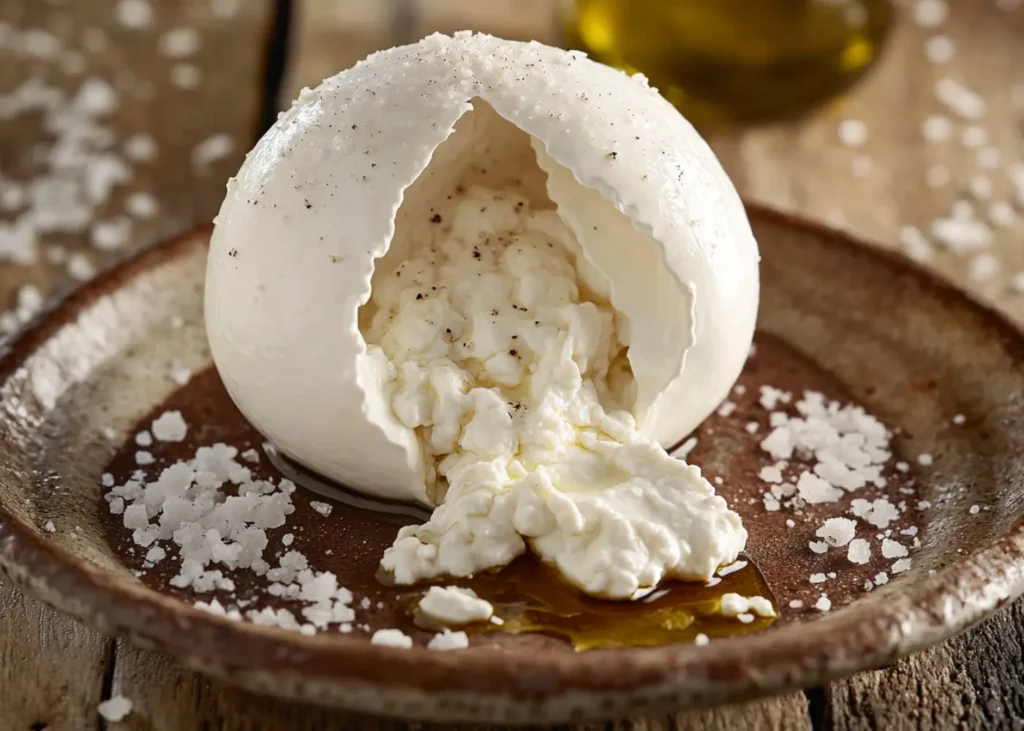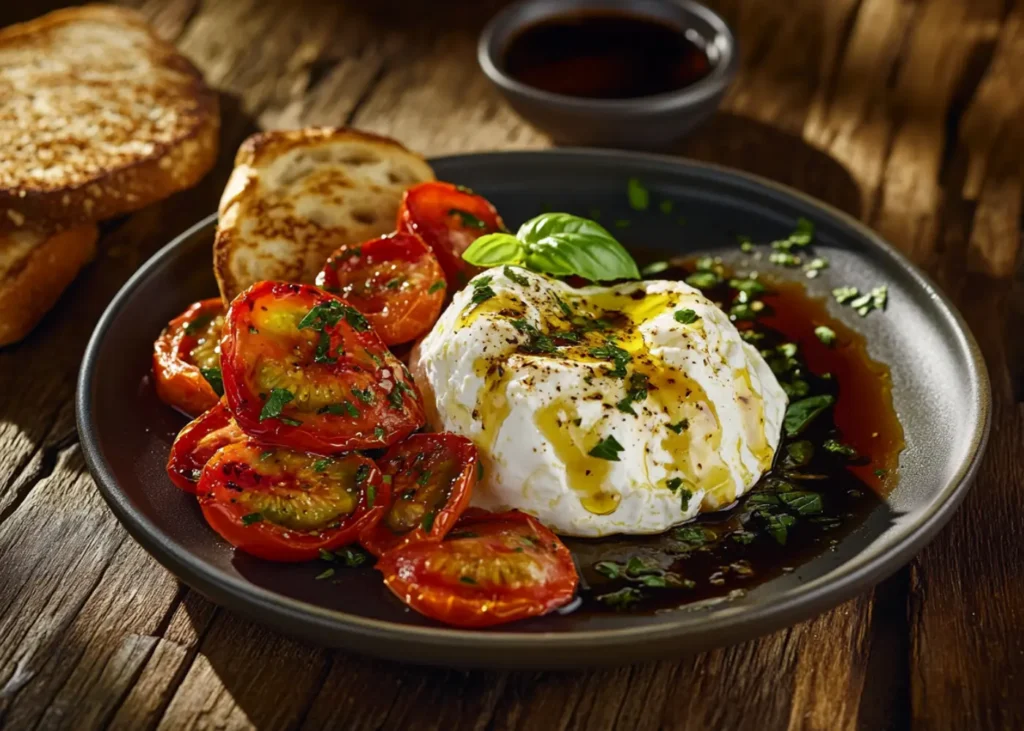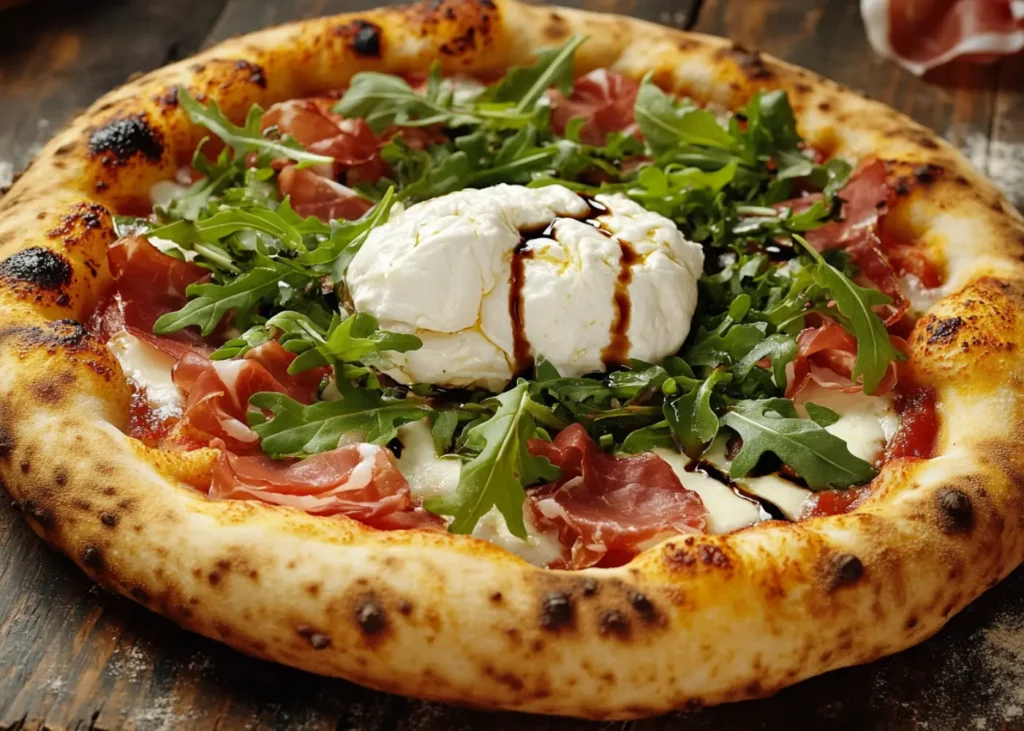Imagine a soft ball of cheese sitting on your plate. When you cut into it, creamy filling gently flows out, inviting you to take a bite. Burrata feels like a simple yet special treat.
Burrata Cheese comes from Italy, where cheesemakers found a way to use leftover mozzarella. They wrapped fresh mozzarella around soft curds mixed with cream. Because of this, burrata is smooth, rich, and full of flavor.
You can enjoy burrata in easy and tasty ways. For example, serve it with warm bread and olive oil for a classic pairing. Additionally, try it as a topping for salads, pasta, or pizza for something different
Let’s dive into the creamy world of burrata cheese!
Table of Contents
What Is Burrata Cheese?
A. Defining Burrata Cheese
Burrata cheese is a delightful treat with every bite. It consists of a stretchy outer layer of mozzarella, which is filled with a soft cream and cheese curd called stracciatella. When you cut into it, the creamy center spills out gently, making it both fun and delicious.
Unlike mozzarella, burrata feels softer and creamier due to its filling. While mozzarella stays firm, burrata melts in your mouth, offering a richer experience. Additionally, its mild flavor blends well with many other ingredients, making it versatile in recipes.

Burrata first appeared in Puglia, a region in southern Italy. Cheesemakers created it in the 1900s to use leftover mozzarella and cream, avoiding waste. For this reason, burrata feels both practical and fancy at the same time. Over the years, it has grown popular worldwide for its unique texture and taste.
B. Fun Facts About Burrata Cheese
The name “burrata” comes from the Italian word for butter, which perfectly describes the cheese’s smooth, rich flavor and creamy texture. Cheesemakers chose this name to highlight the soft and special feel of the cheese.
Initially, burrata was made using buffalo milk, which made the cheese even richer and fuller in taste. However, nowadays, most burrata is made with cow’s milk because it is easier to find. Despite this change, burrata has maintained its charm and remains a favorite in Italian cuisine.
Due to its delicate structure, burrata tastes best when fresh. Many people enjoy it on the same day to savor its full flavor. Additionally, burrata pairs perfectly with simple foods like bread, tomatoes, or olive oil, allowing its creamy flavor to shine through.
Preparing and Serving Burrata Cheese
A. Preparing Burrata Cheese
Burrata cheese is at its best when it is served at room temperature. If you have just taken it out of the refrigerator, let it sit for 20 to 30 minutes before serving. This will allow the creamy center to soften and the flavors to develop.
When purchasing burrata, it is often packaged in water to maintain its freshness. Before serving, gently drain the cheese and pat it dry with a clean paper towel. It is important to handle burrata with care to avoid damaging the delicate mozzarella shell.
B. Best Ways to Serve Burrata Cheese
Burrata is a delicious cheese that pairs beautifully with simple ingredients to make its flavor shine. One classic way to enjoy burrata is to serve it with fresh bread and a drizzle of olive oil. The creamy texture of burrata perfectly complements the crusty bread, creating a rich and satisfying bite.

Another popular option is to add burrata to a salad with heirloom tomatoes. Sprinkle with sea salt and fresh basil for a dish that feels like summer on a plate. If you enjoy cheese-based dishes, try our Easy Habanero Cheese Tips and Recipes for a spicy, flavorful twist.
For a fun twist, try burrata on pizza or pasta. The cheese melts slightly when placed on warm dishes, adding a creamy finish. Additionally, burrata works wonderfully as a dip for roasted vegetables or as a topping for crackers at parties.
C. Creative Presentation Ideas
Presentation can make your burrata dish even more inviting. For an elegant touch, decorate your plate with edible flowers or fresh herbs. These small details add color and charm to the dish.
If you’re hosting a gathering, serve burrata on a wooden board alongside charcuterie and fresh fruits. Pairing it with prosciutto, figs, and honey creates a visually stunning and tasty centerpiece. Additionally, this setup lets guests build their own perfect bite.
For individual servings, consider placing small portions of burrata in mini bowls. Drizzle each portion with olive oil and sprinkle with cracked pepper for a simple yet stylish look. These personal touches ensure every guest feels special.
Burrata Recipes Ideas
A. Recipes for Appetizers and Snacks
1. Tomato Burrata Recipe
Ingredients
- 2 balls of burrata cheese
- 4 ripe tomatoes, sliced
- 2 tablespoons olive oil
- 1 teaspoon balsamic vinegar
- Fresh basil leaves for garnish
- Salt and pepper to taste
Instructions
- To start, cut the tomatoes into slices and arrange them on a plate.
- Next, place the burrata balls in the center of the plate.
- Then, pour olive oil and balsamic vinegar over the tomatoes and cheese.
- Finally, season with salt and pepper, and add fresh basil leaves for garnish.
Pro Tips
- For a richer flavor, use heirloom tomatoes, which are vibrant and sweet.
- Serve the burrata immediately to savor its fresh, creamy texture.
- For a spicy touch, sprinkle some chili flakes on top.
2. Marinated Burrata Recipe
Ingredients
- 2 balls of burrata cheese
- ½ cup halved cherry tomatoes
- 2 tablespoons balsamic vinegar
- 2 tablespoons olive oil
- 1 teaspoon dried oregano
- Salt and pepper to taste
Instructions
- Firstly, mix olive oil, balsamic vinegar, oregano, salt, and pepper in a bowl.
- Then, add the halved cherry tomatoes and toss to coat evenly.
- Next, place the burrata on a serving plate and spoon the marinated tomatoes over it.
- Finally, drizzle with the remaining marinade and serve with crusty bread.
Pro Tips
- Marinate the tomatoes for at least 15 minutes to enhance the flavors.
- Besides oregano, fresh thyme or basil works beautifully for a stronger aroma.
- Finally, pair with a light salad for a balanced starter.
B. Salads
1. Burrata Salad Recipe
Ingredients
- 2 balls of burrata cheese
- 1 cup mixed greens
- 1/2 cup cherry tomatoes, halved
- 1 tablespoon olive oil
- 1 teaspoon balsamic glaze
- Salt and pepper to taste
Instructions
- To start, arrange the mixed greens on a large plate.
- Then, scatter the cherry tomatoes over the greens.
- Afterward, add the burrata on top and drizzle with olive oil and balsamic glaze.
- Finally, season with salt and pepper, then toss lightly before serving.
Pro Tips
- Use arugula or spinach for a peppery twist that complements the burrata.
- Additionally, toasted nuts or seeds add a delightful crunch.
- For a refreshing option, chill the salad ingredients before assembling.
If you’re a fan of unique salad variations, don’t miss our Original Mexican Caesar Salad Recipe for a zesty, bold flavor profile.”
C. Entrees Burrata Recipes
1. Burrata Pasta Recipe
Ingredients
- 1 pound pasta (spaghetti or fettuccine)
- 2 balls of burrata cheese
- 2 tablespoons olive oil
- 3 garlic cloves, minced
- 1 cup cherry tomatoes, halved
- ½ cup fresh basil leaves
- Salt and pepper to taste
Instructions
- Firstly, cook the pasta according to the package instructions. Drain it and set aside.
- Next, heat olive oil in a pan and sauté garlic until it becomes fragrant.
- After that, add the cherry tomatoes and cook until they soften, about 5 minutes.
- Then, mix the cooked pasta with the tomato mixture and season with salt and pepper.
- Finally, place the burrata cheese on top of the pasta and garnish with fresh basil before serving.
Pro Tips
- For a healthier option, use whole-wheat pasta instead of regular pasta.
- Additionally, break the burrata open at the table for a dramatic, creamy presentation.
- Add Parmesan cheese for an extra savory touch.
2. Burrata Pizza Recipe

Ingredients
- 1 pizza crust (store-bought or homemade)
- 2 balls of burrata cheese
- ½ cup marinara sauce
- 1 cup fresh arugula
- 2 tablespoons olive oil
- 1 teaspoon truffle oil (optional)
Instructions
- To start, set the oven to 450°F (230°C).
- Then, spread the marinara sauce evenly over the pizza dough.
- Bake the dough for 10-12 minutes, or until it is crispy.
- Next, place the burrata on top of the hot pizza and add arugula.
- Finally, before serving, drizzle with olive oil and, if desired, truffle oil.
Pro Tips
- For a crispier crust, use a pizza stone in the oven.
- Additionally, add sliced figs or prosciutto for a gourmet twist.
- Let the pizza cool slightly before adding burrata to avoid melting.
Health Benefits and Nutrition Facts
A. Health Benefits of Burrata cheese
Burrata cheese is not just a creamy treat; it also provides valuable nutrients. For example, it’s rich in protein, which helps repair and grow muscles. Including burrata in your meals can support an active lifestyle.
Additionally, burrata contains calcium, which is essential for healthy bones and teeth. A single serving provides a significant portion of your daily calcium needs. This makes it a delicious way to promote strong bones.
Moreover, burrata has vitamins B2 and B12, which are important for energy production and red blood cell formation. These nutrients help maintain overall health and prevent fatigue. Consequently, burrata can be a flavorful part of a balanced diet.
B. Burrata Cheese Nutritional Information
Here’s a quick look at the nutritional profile of burrata. The following values are based on a typical serving size of one burrata ball, approximately 120 grams:
| Nutrient | Amount | % Daily Value* |
|---|---|---|
| Calories | 300 | – |
| Protein | 15g | 30% |
| Total Fat | 25g | 38% |
| Saturated Fat | 15g | 75% |
| Cholesterol | 100mg | 33% |
| Sodium | 300mg | 13% |
| Carbohydrates | 2g | 1% |
| Calcium | 200mg | 20% |
| Vitamin B12 | 1.3mcg | 54% |
*Percent Daily Values are based on a 2,000-calorie diet. Your individual needs may vary.
C. Balance and Moderation
Burrata is a nutrient-rich food, but it is also high in fat and calories. A single serving contains 25 grams of fat, most of which is saturated. Therefore, it is important to consume burrata in moderation as part of a balanced diet.
To make the most of burrata, pair it with fresh vegetables, fruits, or whole grains. For example, serve it with a tomato salad or on whole-grain toast for added fiber. These combinations not only enhance the flavor but also provide a more balanced nutritional profile.
In summary, burrata can be a delightful addition to your meals when enjoyed in moderation. Its creamy texture and unique taste make it a treat to savor, especially when paired with nutrient-dense foods.
Storing and Handling Burrata cheese
A. Storage Tips
Proper storage ensures your burrata stays fresh and safe to eat. Always keep burrata in its liquid and store it in the refrigerator. It can last up to two days this way. Additionally, avoid removing it from the liquid until you’re ready to use it, as this keeps it moist and flavorful.
However, freezing burrata is not recommended. Freezing changes its creamy texture and makes it less enjoyable to eat. If you need to store burrata for longer, consider using it in recipes that can be frozen instead, like pasta sauces.
B. Signs of Spoilage
Knowing when burrata has gone bad is important for your safety. Firstly, check for a sour smell or slimy texture, which are clear signs of spoilage. Also, look at the liquid it’s stored in. If the liquid looks cloudy, blue, or smells strange, it’s best to throw it away.
Also, burrata should feel soft but not mushy. If the shell feels too hard or the center looks wrong, it may not be fresh anymore. To enjoy burrata the best, always use it within its recommended time to keep it fresh..
Burrata cheese FAQs
What is the best way to use burrata?
Pair it with fresh ingredients like tomatoes, basil, and olive oil. These simple flavors complement burrata’s creamy texture and mild taste.
What can I do with a ball of burrata?
You can serve it whole on a plate, split it open to reveal the creamy center, or use it as a topping for dishes like pizza or salad. Burrata’s versatility makes it perfect for any meal.
What is the point of burrata?
Burrata elevates dishes with its rich, creamy texture and indulgent flavor. Its soft center brings a luxurious touch to any recipe, whether simple or gourmet.
Is burrata good for you?
Burrata is high in protein and calcium, which are beneficial for muscles and bones. However, it’s also rich in fats, so enjoy it in moderation as part of a balanced diet.
Can I substitute ricotta for burrata?
While ricotta and burrata are not identical, ricotta can work in recipes requiring creaminess. For example, use ricotta as a filling for pasta or as a spread on toast when burrata is unavailable.
What is the closest cheese to burrata?
Stracciatella, the creamy filling inside burrata, is the closest match. Mascarpone also offers a similar texture and richness, making it a suitable alternative in some dishes.
Is burrata healthy for weight loss?
Burrata is calorie-dense because of its creamy center and high fat content. While it’s not ideal for weight loss, enjoying it occasionally in small portions can fit into most diets.
Burrata Cheese Pairings and Ideas
A. Perfect Pairings
Burrata is delicious with flavors that match its creamy taste. For drinks, light white wines like Sauvignon Blanc or a crisp rosé are good. The slight tartness of these wines balances the richness of the cheese.
To complete your burrata experience, pair it with our refreshing Virgin Island Pina Colada Recipe for a tropical, creamy contrast
Fresh figs, peaches, or strawberries go well with burrata. Their sweetness matches the mild taste of the cheese, making every bite fresh and creamy. For bread, rustic sourdough or toasted baguette adds a nice crunch to balance the soft texture of burrata.
B. Regional Variations
In Italy, burrata Cheese is often served with simple, tasty sides. Pair it with cured meats like prosciutto and drizzle with olive oil for a classic dish. This keeps the focus on the cheese’s buttery flavor.
For something new, try burrata with spicy honey or pomegranate seeds. The honey gives a sweet kick, while the seeds add a juicy, tangy pop. These pairings also bring bright colors to your plate, making the dish stand out even more.
Conclusion
Burrata is not just cheese; it’s a special treat for any meal. Its soft texture and sweet taste work well in appetizers, salads, or main dishes. Whether you serve it with bread, fresh fruit, or strong spices, burrata transforms simple food into something unforgettable.
Trying new recipes or food pairings can make burrata even more enjoyable. If you love creamy, indulgent flavors, you might also enjoy our Easy Crab Brûlée Recipe, a delightful fusion of seafood and richness.
Let burrata be the star of your next meal. Its creamy magic will impress your family and friends. Explore all the ways you can use this great cheese and create dishes that everyone will love!

